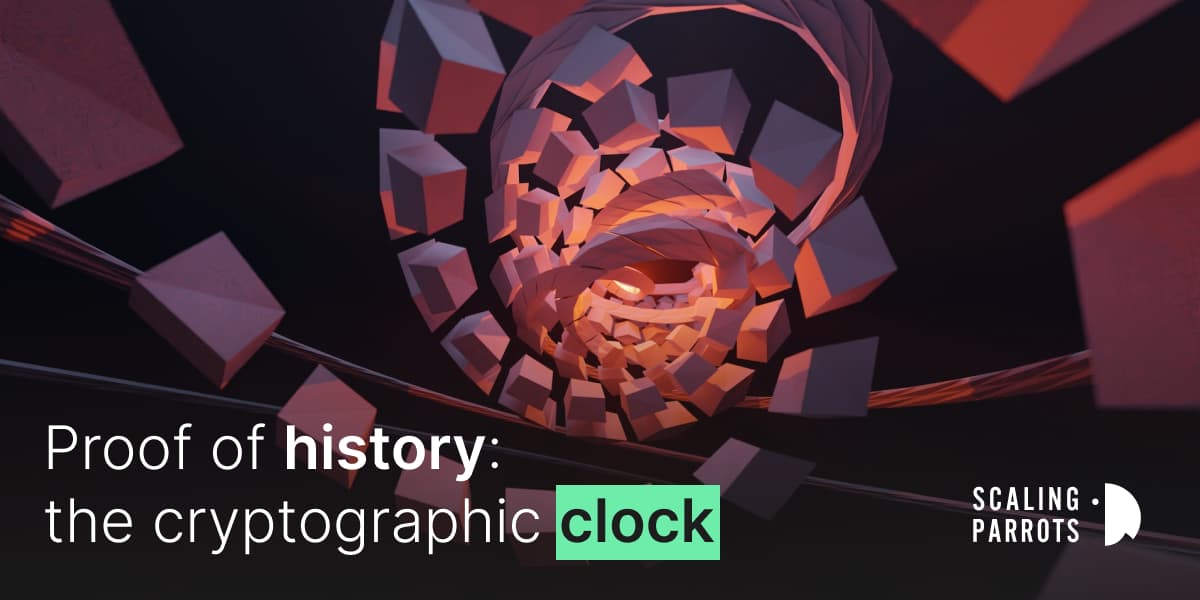
The Proof of History consensus mechanism is based on the idea that you can use a simple and reliable cryptographic method to create a secure ordering of events. In the context of a Blockchain, the ordering of blocks is critical, and this ordering is also what creates the chain finality.
A PoH Blockchain is built on a protocol that requires each block to have an ordering. It also means that each block will be linked to a specific point in time of the transaction.
This article will explain more about what Proof of History is and how Proof of History works.
What is Proof of History?
A Proof of History (PoH) protocol-based Blockchain relies on a cryptographic method to generate a trustworthy ordering of transactions/events recorded to the ‘ledger’ in order to overcome the issue of time agreement, and it enables the almost instant finality of thousands of transactions per second.
In a Blockchain system, each block has a timestamp, and the ordering of blocks is critical.
The ordering also establishes the chain’s finality, which means no other block will be added at the same height once a block is added to the chain.
A Blockchain system is an ordered, decentralized and distributed system that is built on a protocol that requires each block to have an order.
It also means that each block will be linked to a specific point in time of the transaction. This can be problematic, however, as it can be challenging to agree on a globally consistent ordering of transactions that are happening across the network, particularly when there are many transactions per second.

How Does Proof of History Work?
Time stamps are created in Proof of History to prove that a block was created at a specific time. Consider this: if you photograph an athletics competition at the Olympic Games, you create proof that the photograph was taken during that competition because the competition took place at a specific time, neither before nor after.
Proof of History is a historical record proving an event occurred at a specific time.
As of this writing, Solana is the only Blockchain to utilize the Proof of History algorithm.
The SHA256 hash function (also known as a ‘digest’, a type of signature for a text or data file) is used to hash all events and transactions on the Solana Blockchain. This function takes an input and produces an output that is impossible to predict.
Solana takes a transaction’s output and feeds it into the next hash. The transaction sequence is now embedded in the hashed output.
This hashing process results in a long, uninterrupted chain of hashed transactions. Without the need for a conventional timestamp, this property generates a clear, verifiable sequence of transactions that a validator adds to a block. Hashing also takes time to complete, so validators can quickly determine how much time has passed.
The Solana PoH protocol is basically a clocking system for Blockchain events. Timing is critical for Blockchain systems because of how they create an ever-growing chain of blocks.
In other words, the order of the blocks within the chain determines the order of all events that take place. This can cause issues if nodes don’t agree on the correct ordering of events.
For example, let’s imagine two different nodes trying to add a transaction. If they both add them at the same time, the nodes will have to agree on which transaction gets added first.
Since timing is essential, let’s also imagine that both nodes have a clock that is synchronized to the same time server. The clocks run independently so that they will have slightly different times. The node with the lower clock time will always win the race to add a transaction, and the other node will have to start again with a new transaction.
The Solana whitepaper is a good illustration of how proof of history works.
The Solana Whitepaper
The Solana whitepaper goes into detail about the protocol and how it works. It also includes information on the project’s end goal: to create a decentralized web-scale Blockchain that can process millions of transactions per second.
The whitepaper starts with a description of the problem that Solana is trying to solve. Existing Blockchain designs rely on slow consensus algorithms and only process a few transactions per second. The whitepaper also describes how the PoH protocol can create a Blockchain that can process thousands and millions of transactions per second.
What Are The Benefits of Proof of History?
The most important benefit of the PoH protocol is that it allows the Blockchain to have a consistent ordering of events. This consistency allows the Blockchain to be decentralized because every node can agree on the order of events occurring on the network.
Another benefit of the PoH protocol is that it allows the Blockchain to have almost instant finality. This means that once a block is added to the chain, no other block will be added at the same height. This means that no forks or other issues come with a consensus algorithm’s flexibility.
Solana PoH protocol can create a Blockchain that can handle thousands of transactions per second. Since there are no forks and the finality is almost immediate, the network can handle high-volume transaction processing.
The Proof of History also has other benefits;
- High Performance
The first benefit of the Proof of History Blockchain design is that every node on the network has an independent consensus algorithm. This means that every node will create its chain and ignore the consensus of other nodes on the network.
This provides a lot of flexibility and allows each node on the network to choose the tradeoff between latency and finality. The Solana architecture is built to support high performance by selecting the consensus algorithm that best suits the hardware.
- A Clock For Blockchain
A Blockchain is an ordered, decentralized and distributed system that is built on a protocol that requires each block to have an order. It also means that each block will be linked to a specific point in time of the transaction.
This can be problematic, however, as it can be challenging to agree on a globally consistent ordering of transactions that are happening across the network, particularly when there are many transactions per second.
A PoH protocol-based Blockchain relies on a cryptographic method to create a reliable ordering of transactions/events recorded to the ledger to solve the issue of time agreement, and it allows for almost instant finality of transactions thousands of transactions per second.
- Web-Scale
Web-scale is a term that denotes systems that are intended to support the load of large-scale internet applications. PoH is designed to be a web-scale Blockchain, meaning it can handle millions of transactions per second.
The key to creating a Blockchain that can process millions of transactions per second is using a consensus algorithm optimized for throughput.
- High-Performance Implementation Of PBFT
The most widely used consensus algorithm for high-performance Blockchains is Practical Byzantine Fault Tolerance (PBFT). Proof of History uses a high-performance implementation of PBFT to create a Blockchain that can process millions of transactions per second.
The Solana Blockchain architecture is designed to be scalable, meaning that it can process millions of transactions per second. The architecture is designed to handle the most throughput-oriented consensus algorithm, which is PBFT.
The Solana Blockchain uses a high-performance implementation of PBFT to create a highly scalable Blockchain that can process millions of transactions per second.
Examples of Proof of History
Blockchain projects that use the Proof of History consensus mechanism include;
- Solana – Solana is a PoH Blockchain built for high-throughput dApps. The Solana Blockchain is an excellent example of how a PoH Blockchain works. It can handle over 10,000 transactions per second and supports decentralized applications. It can achieve this by using a hybrid system combining PoW, PoS, and PoH.
- Filecoin – Filecoin is a decentralized storage network built on a PoH Blockchain.
- Hashgraph – Hashgraph is another PoH Blockchain.
These are just a few examples of Blockchain projects that use the Proof of History consensus mechanism.
What Are Some Potential Issues With Proof Of History?
There are a few potential challenges that PoH will have to solve. These challenges are often associated with this consensus mechanism and have to be solved. Solana Proof of History consensus mechanism will have to prove itself against these challenges.
- Centralized system
The problem with Solana’s proof of history is that the system is centralized. While this could be seen as a benefit, it also has its drawbacks. The system relies on one trusted entity to verify the data and pass it along to other entities in the network. If this entity is hacked or corrupted, the integrity of the network could be threatened.
If the computers managing and generating the hashes are not secured well enough, they can be hacked. If a specific computer that is generating the hashes is compromised, it can be used to generate a false order.
Furthermore, being centralized also means that all users must trust the same entity to use the network. This can be problematic if different entities have different agendas.
- Slow
The Solana proof of history system is also slow. It takes time for any data to travel through the network. As a result, small businesses find it challenging to adopt the platform. In addition, it can be expensive for large companies to participate in the network due to the high fees associated with using the system.
- Large amount of computing power
Another challenge is that PoH is a form of proof of work (PoW) that requires a large amount of computing power to be successful. To ensure that the PoH is successful, there would have to be a significant amount of processing power and energy.
Proof of history requires a large amount of computing power at each node. This limits the number of nodes that can be deployed, which can make it difficult for smaller businesses to adopt the platform.
If a PoW Blockchain is used, it would require a large amount of computing power to keep the ledger secure. With PoW, a lot of computing power is required to solve algorithms to add blocks to the Blockchain.
More computing power means that there is greater potential for large energy consumption. This can create issues for the environment and the Blockchain network.
- Fewer decentralized applications (dApps)
Finalized Blockchains are designed to be used for cryptocurrencies and other applications that require a high level of trust. PoH Blockchains are more centralized and don’t provide the same level of trust. Cryptocurrencies like Bitcoin and Ethereum are PoW Blockchains, and they are designed to be used in a trustless environment.
PoH Blockchains are trust-based and are not as suitable for dApps that require a high level of trust and security.
- Strict requirements to participate as a validator
PoH Blockchain is a public Blockchain, and anyone can participate in it. However, the public Blockchain does have a level of trust between all the participants. The trust is that all participants are honest and follow the Blockchain’s rules. PoH has a few requirements to meet if you want to participate in the Blockchain as a validator.
There are strict requirements to participate as a validator, so the number of nodes will be low, and the system will be centralized. To participate, you must have a high-performance computer capable of generating lots of hashes per second.
- Additional Hardware capacity
In addition, Solana’s verification system needs to handle millions of transactions per second and process a large number of transactions simultaneously. This requires additional hardware capacity, as well as increased computing power.
Solana also needs to find a way to store all the data before it is used to keep it secure and prevent tampering. This can be expensive and time-consuming, so Solana must find a way to make this part of its proof-of-history process as efficient as possible.
- Lots of users to distinguish
Another challenge with Solana’s proof-of-history system is that it must be able to distinguish between multiple users using the same account or transaction history. An attacker could create false data on one of these accounts to get around the verification process.
Ideally, Solana’s system would be able to detect this by comparing different sets of data from different sources; if they differ in some way, then a discrepancy would be flagged for further investigation.
- High-Frequency Trading
Finally, Solana’s proof of history is not designed to handle high-frequency trading (HFT). Because HFT relies on faster transactions and more data flowing through the system, there is little room for error under these conditions.

Conclusion
Proof of history is one of the consensus mechanisms that seems to be a good fit for high throughput Blockchain. It has been designed to be a scalable and high-performance consensus mechanism.
The PoH Blockchain has been designed to be a public Blockchain that can handle a high volume of transactions per second. It can handle over 10,000 transactions per second.
There are some potential issues that PoH will have to overcome to succeed. These include centralization, a large amount of computing power, and strict requirements to participate as a validator. These are just a few challenges that PoH will have to overcome. It is yet to be seen how PoH will perform in real-world applications in the long run.
See you soon,
Scaling Parrots
